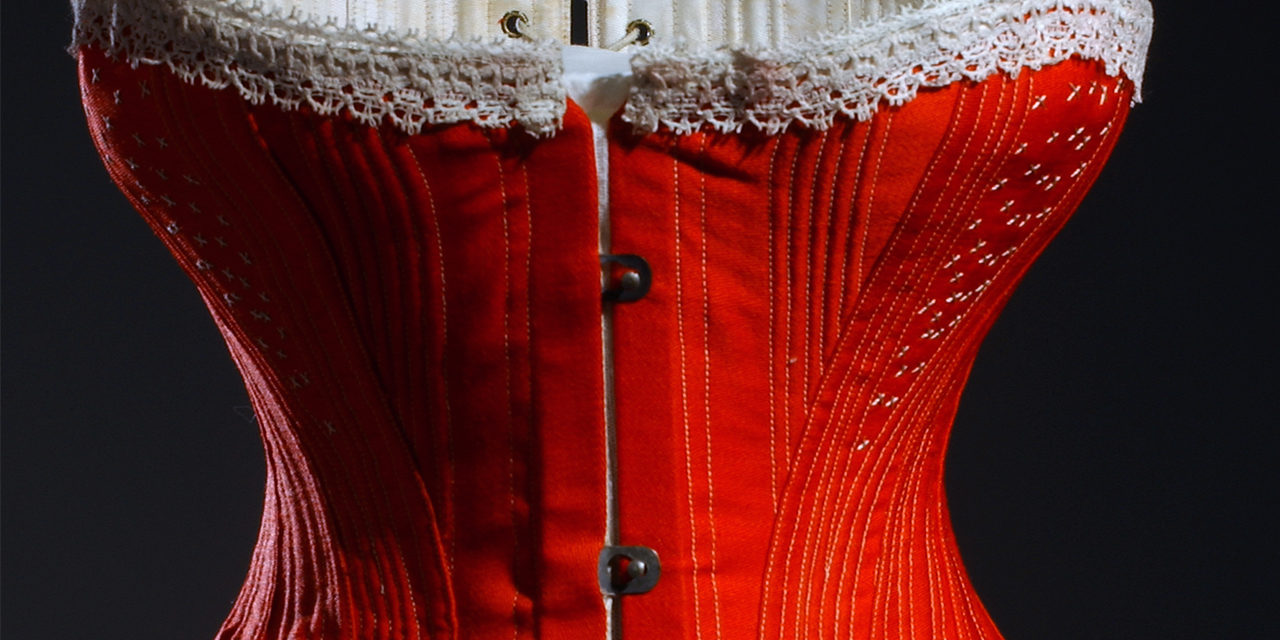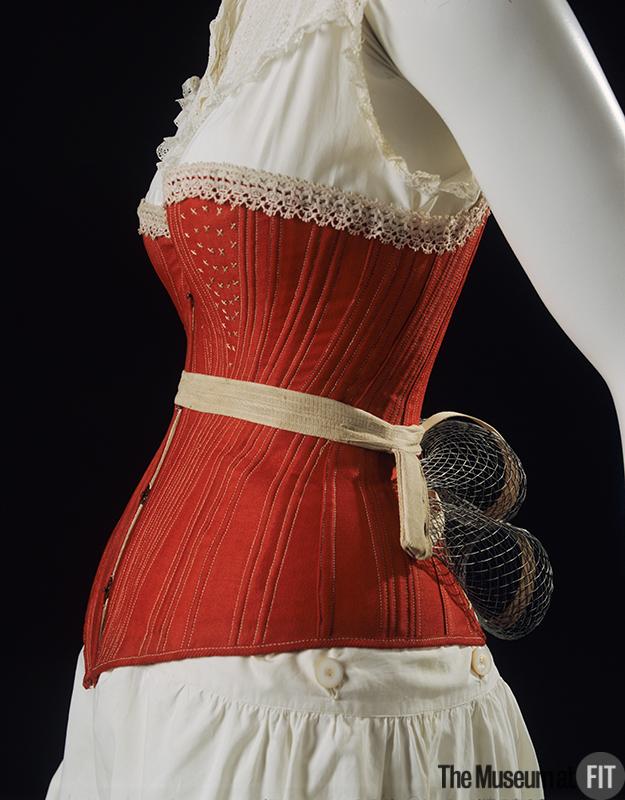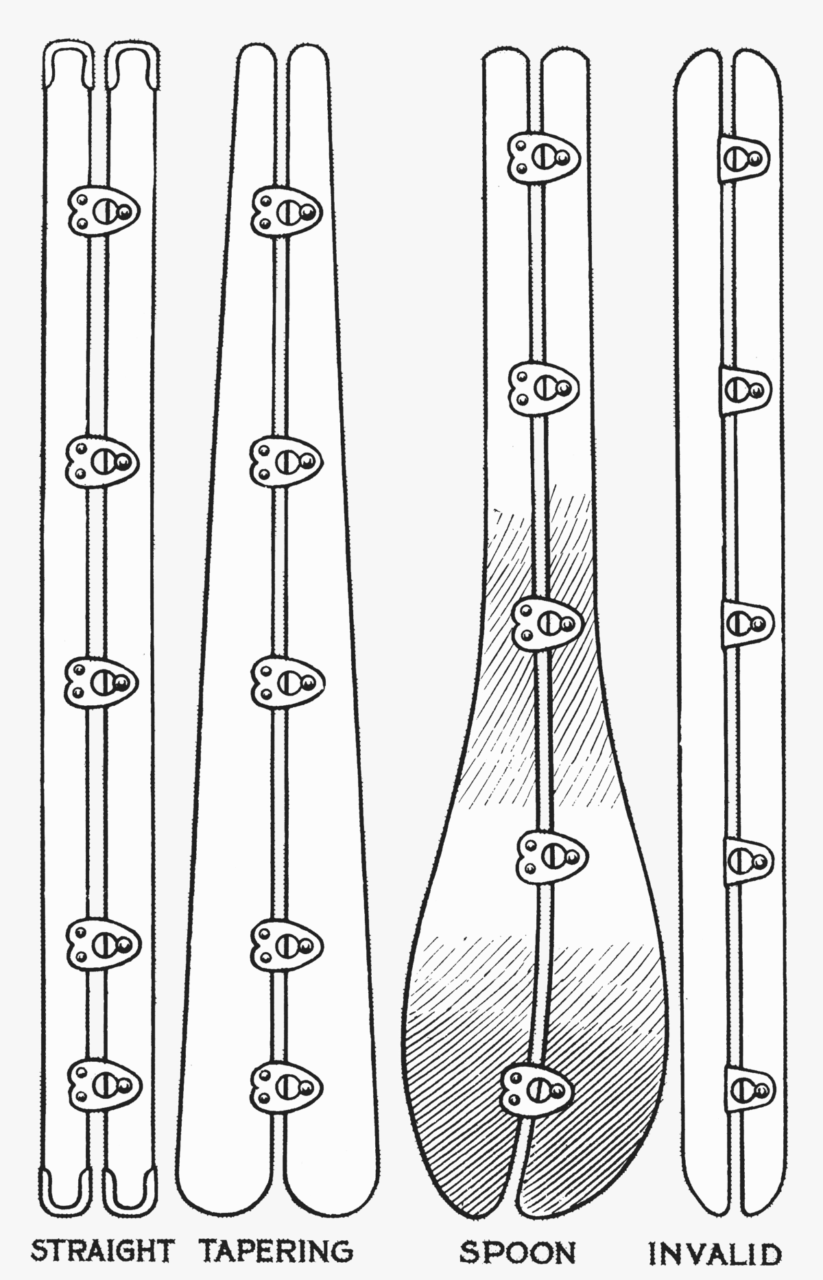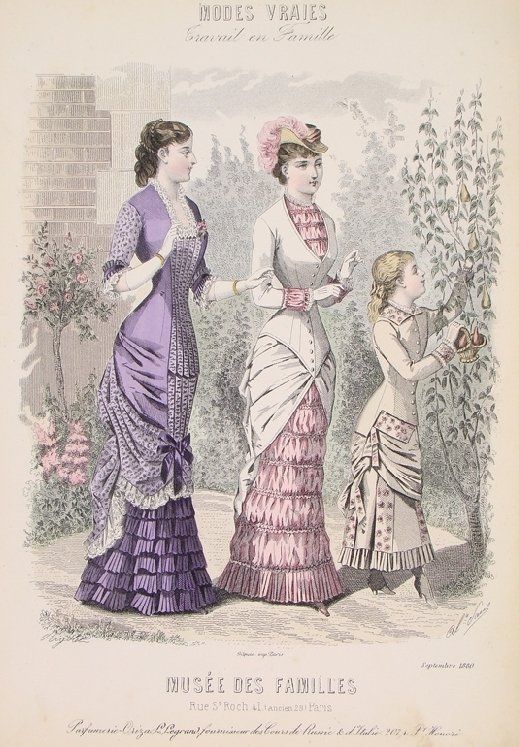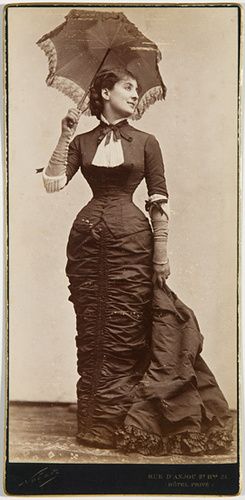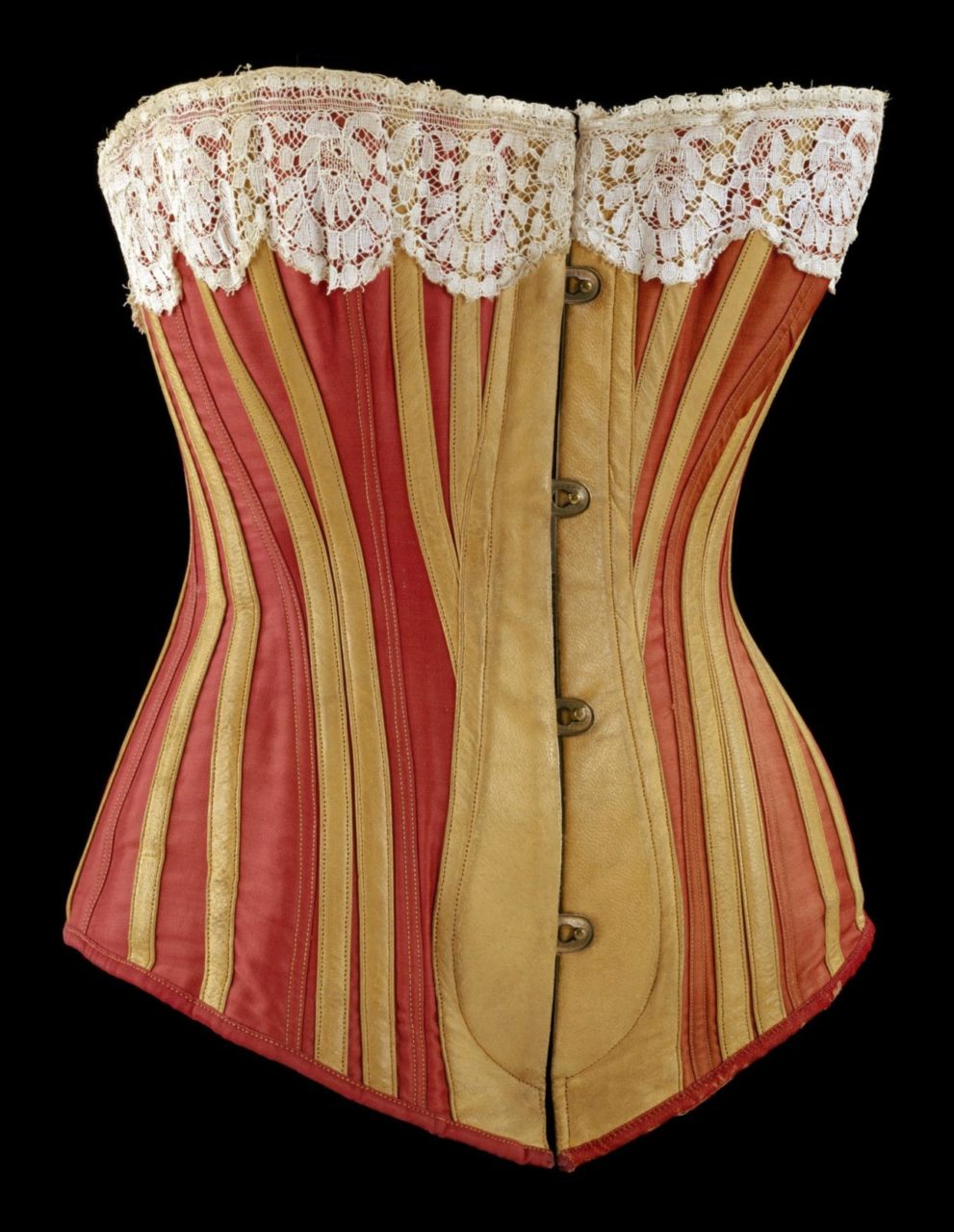This brightly colored corset with steel boning and a front-opening spoon busk was a highly fashionable foundation garment for a woman’s wardrobe in the 1880s.
About the Look
T
his corset from 1880 is made from bright red wool and is edged with a delicate white cotton lace trim along the top of the garment. Like other fashionable corsets of the late Victorian era, this garment features a smooth ‘hourglass’ silhouette with a large bust, small waist, and full, rounded hips. As described by the Museum at FIT, highly structured foundation garments such as this corset were used to exaggerate “the sexually-dimorphic curves of the female body.” This impressive silhouette (Fig. 1) is created through careful shaping of fabric panels. In order to maintain a smooth look, this corset is fully boned with a combination of whalebone and steel boning.
This piece features a steel ‘spoon’ busk, invented in 1873, in the front which would lay tight against the body (Fig. 3). The spoon busk is named for its spoon-like shape in comparison to the flat, straight busks that were otherwise used (Fig. 7). Spoon busks are curved along the front of the abdomen to produce the gentle rounded look that was fashionable during the period and to ensure that there is no harsh edge from the bottom of the corset poking out beyond the belly. Not only does the busk help to produce the fashionable silhouette of this corset, it serves as a closure along the front of the corset, making the garment easier to put on and take off. This corset is laced up in the back with a cream-colored silk cord (Fig. 2).
Additional detailing on this garment includes contrasting cream stitching along the numerous bone channels throughout the corset and along the bottom edge, as well as cream embroidery on the bust gussets. It is lined in white silk.
Fig. 1 - Designer unknown (French). Corset, 1880. Wool, silk, steel, cotton lace, whalebone. New York: Museum at FIT, 98.29.3. Museum purchase. Source: Museum at FIT
Fig. 2 - Designer unknown (French). Corset, 1880. Wool, silk, steel, cotton lace, whalebone. New York: Museum at FIT, 98.29.3. Museum purchase. Source: Museum at FIT
Corset, 1880. Red wool with steel boning and spoon busk, white cotton lace and silk cord lacing. New York: Museum at FIT, 98.29.3. Source: Museum at FIT
About the context
The corset was an essential garment in a woman’s wardrobe during the 1880s. After the Industrial Revolution, corsets were often manufactured using steel boning, which was both more durable than whalebone and stiffer than cording. This allowed for corsets to take on new silhouettes after 1840, one of which was called the “hour-glass” and was highly desirable during the 1880s and 1890s (Gay 13). Not only could steel be used for heavy-duty boning, but the two-part busk, also made of steel, made corsets considerably easier to take on and off. The invention of the two-part busk made corsets easier to use for women who could not afford a maidservant or have a family member to help them dress. Not only could corsets be taken on and off more easily, but advances in manufacturing allowed for cheaper, ready-to-wear corsets to become available to working women. As a result, ‘fashionable’ corsets became a part of most women’s daily dress, and by the 1880s the corset had “become a very elegant and desirable object” (V&A) (Figs. 4 & 5).
Fig. 3 - Spirella Corsets (American or British). Front Clasps for Corsets, 1913. Source: Wikipedia
Fig. 4 - Artist unknown (French). Musée des familles, September 1880. Source: Pinterest
Fig. 5 - Nadar (French, 1820-1910). Alice Regnault, 1880. Albumen print. Source: Galleri Balder
Fig. 6 - Designer unknown (English). Corset, 1883. Red sateen, beige leather and whalebone, with a steel spoon-shaped busk. London: Victoria and Albert Museum, no T.84-1980. Source: Victoria and Albert Museum
Due to the quick growth and popularity of corset production, many manufacturers began making corsets in a “greater variety of materials, color, size and fit” (V&A). This resulted in the appearance of brightly colored corsets such as those in figures 6 and 7, which were made from materials including coutil (a tightly woven cotton fabric made specifically for corsets), silk, wool, leather, and cotton. Before the 1870s, corsets tended to be made only in neutral colors “as colorful corsets had been associated with the ‘aristocracy of vice’ only a decade earlier,” but by 1880 brightly colored corsets were “highly fashionable” despite the traditional controversy (Museum at FIT).
The red corset shown was made in France in 1880 and would have been considered a highly fashionable garment that was often worn. Its modern construction (a steel spoon busk and boning) and creative material (red wool outer fabric and a silk lining) made it a top-of-the-line foundation garment for a highly fashionable French woman. The bright red wool was not a fabric that was fashionable for corsetry at the time, but it was coming into style as ‘healthier’ for women. In 1879, Dr. Gustav Jaeger began promoting wool corsets as a “healthy alternative to silk or cotton” due to wool’s natural wicking ability (V&A). While linen is also a wicking material and had been a common material for undergarments in previous centuries, it was no longer in fashion for corsetry. Wool was the obvious choice for doctors to fall back on in order to create a comfortable, daily wear garment for women.
This corset’s hourglass silhouette, which may have been padded out with inserts, exaggerated a woman’s curves into the desired body shape of the period (Fig. 5).
Fig. 7 - Designer unknown (American). Corset, 1880s. Cotton. New York: The Metropolitan Museum of Art, C.I.48.48a, b. Gift of Mrs. Aline Bernstein, 1948. Source: The Metropolitan Museum of Art
References:
- “Corsets and Bustles from 1880-90 – The Move from Over-Structured Opulence to the ‘Healthy Corset’.” The Victoria and Albert Museum. http://www.vam.ac.uk/content/articles/c/corsets-and-bustles-1880-1890-from-over-structured-opulence-to-the-healthy-corset/
- Gay, Fannie P. “DRESS REFORM.” Ladies’ Home Journal and Practical Housekeeper. Vol. 5, Iss. 7, (Jun 1888): 13. https://libproxy.fitsuny.edu:2818/docview/1715483542?accountid=27253.rset/?et_fb=1&PageSpeed=off
- Summers, Leigh. “Yes, They Did Wear Them: Working-Class Women and Corsetry in the Nineteenth Century.” Costume 36, no. 1 (2002): 65-74. https://www.euppublishing.com/doi/abs/10.1179/cos.2002.36.1.65?journalCode=cost
- Vincent, Susan J. “Breasts and Waist.” In The Anatomy of Fashion: Dressing the Body from the Renaissance to Today, 35–60. Oxford: Berg, 2009. http://dx.doi.org/10.2752/9781847888617/ANAOFFASH0003.

